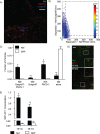MIiSR: Molecular Interactions in Super-Resolution Imaging Enables the Analysis of Protein Interactions, Dynamics and Formation of Multi-protein Structures
- PMID: 26657340
- PMCID: PMC4676698
- DOI: 10.1371/journal.pcbi.1004634
MIiSR: Molecular Interactions in Super-Resolution Imaging Enables the Analysis of Protein Interactions, Dynamics and Formation of Multi-protein Structures
Abstract
Our current understanding of the molecular mechanisms which regulate cellular processes such as vesicular trafficking has been enabled by conventional biochemical and microscopy techniques. However, these methods often obscure the heterogeneity of the cellular environment, thus precluding a quantitative assessment of the molecular interactions regulating these processes. Herein, we present Molecular Interactions in Super Resolution (MIiSR) software which provides quantitative analysis tools for use with super-resolution images. MIiSR combines multiple tools for analyzing intermolecular interactions, molecular clustering and image segmentation. These tools enable quantification, in the native environment of the cell, of molecular interactions and the formation of higher-order molecular complexes. The capabilities and limitations of these analytical tools are demonstrated using both modeled data and examples derived from the vesicular trafficking system, thereby providing an established and validated experimental workflow capable of quantitatively assessing molecular interactions and molecular complex formation within the heterogeneous environment of the cell.
Conflict of interest statement
The authors have declared that no competing interests exist.
Figures







References
-
- Fairn GD, Grinstein S. How nascent phagosomes mature to become phagolysosomes. Trends Immunol. Elsevier Ltd; 2012; 1–9. - PubMed
Publication types
MeSH terms
Substances
Grants and funding
LinkOut - more resources
Full Text Sources
Other Literature Sources

